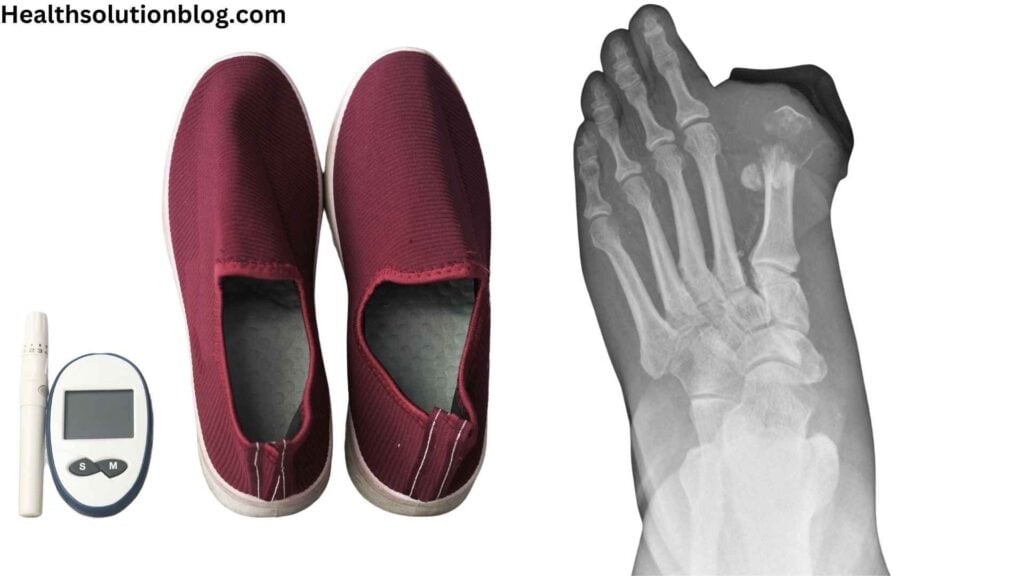
Diabetes patients must take special care of their feet. It helps prevent problems and keeps your feet healthy.
Non-care can lead to foot ulcers, which are open sores on the feet and are very common in patients with diabetes. Serious problems may result from these sores.
Some diabetics have undergone toe amputations and lost their toes. Finding the ideal shoes for severed toes is crucial because they have unique footwear requirements.
Finding the ideal diabetic shoes for severed toes can significantly improve the health and comfort of your feet. To help you move confidently toward a better and more pleasant life, we’ll look at the solutions that can be adapted to these particular needs in this article.
I. Understanding Diabetic Shoes
In this section, we discuss what diabetic shoes are, why they are important for foot health, and how they differ from regular shoes.
What are Diabetic Shoes?
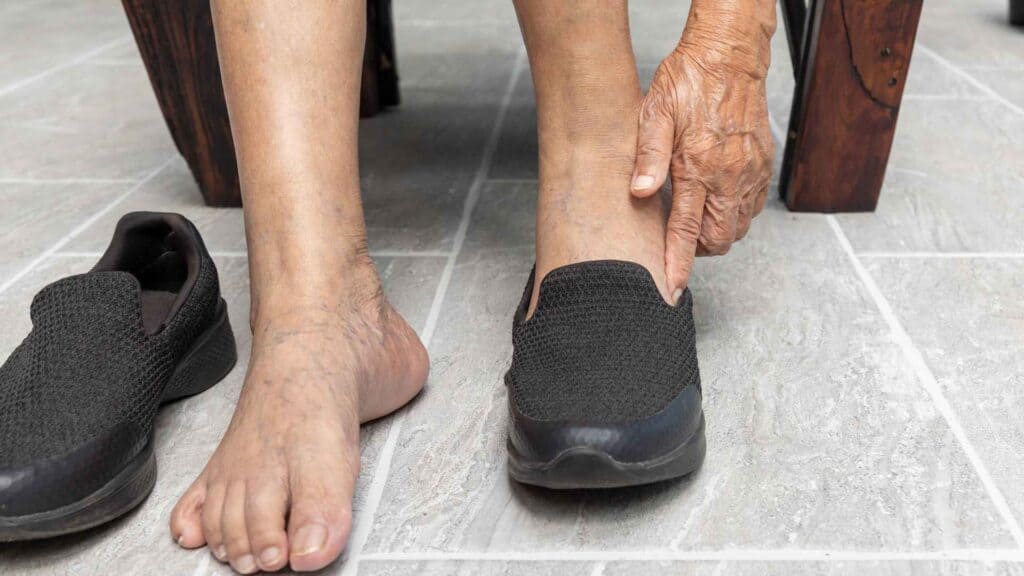
Diabetes sufferers can protect their feet from harm and infection with the help of specially-made diabetic footwear. They are frequently constructed of supple, breathable materials that aid in preventing moisture buildup, which can result in skin issues. To provide comfort and support, diabetic shoes frequently incorporate characteristics like extra-deep toe boxes, broad widths, and cushioned footbeds.
Why Are Diabetic Shoes Vital for Foot Health?
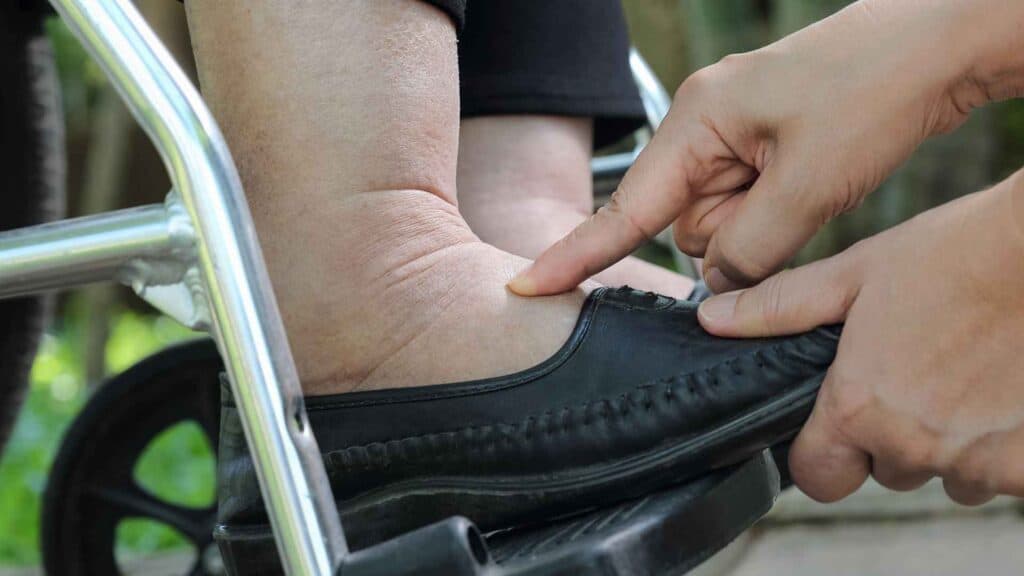
Diabetes increases a person’s risk of acquiring infections, calluses, and other foot issues like ulcers. This is because diabetes has the potential to harm the nerves and blood vessels in the foot, which might restrict circulation and sensation. Diabetic shoes can help protect the feet from these problems by providing:
i. Comfort and support: Diabetic shoes should be comfortable to wear and offer enough ankle and arch support. This can lessen discomfort and help to avoid injuries.
ii. Protection: In order to avoid rubbing and blisters, diabetic shoes should have a broad toe box and be composed of moisture-resistant materials. This could aid in preventing skin issues.
iii. Stability: To promote stability and prevent falls, diabetic shoes should have a solid sole. This is crucial for those who have neuropathy since it might affect balance.
Distinguishing Between Regular and Diabetic Shoes

There are a few key differences between diabetic shoes and regular footwear. Diabetic shoes are typically:
- made using soft, permeable materials to avoid moisture buildup.
- have toe boxes that are extra-deep to allow swelling and give room for missing toes.
- to accommodate bigger feet, and have wide widths.
- have padded footbeds for support and comfort.
- have sturdy bottoms for stability.
- Detachable orthotics that add additional arch support may be present.
II. How Diabetic Shoes Protect Amputated Toes?
Diabetic shoes can help to protect amputated toes in a number of ways. Off-loading devices, custom inserts, diabetic toe/partial foot fillers, and CROW boots are all effective ways to reduce pressure and friction on the foot, which can help prevent ulcers and other injuries.
Off-loading Devices and Custom Inserts
Off-loading devices and custom inserts are two ways that diabetic shoes can protect amputated toes. Off-loading devices are worn over the shoe and help to distribute pressure evenly across the foot, which can help to prevent ulcers and other injuries. Custom inserts are made specifically for the individual’s foot and can provide additional support and cushioning.
Custom inserts:
Custom inserts can provide more support and cushioning because they are designed specifically for the wearer’s foot. People who have had their toes removed may find this useful as a way to lessen pain and avoid injury. A podiatrist or an orthopedist often creates custom inserts.
The Role of Diabetic Toe/Partial Foot Fillers
Diabetic toe/partial foot fillers are devices that are inserted into the shoe to fill the space left by missing toes. This can help to prevent rubbing and blisters, and it can also help to improve the fit of the shoe.
CROW Boots: An Off-loading Solution
CROW (Charcot Restraint Orthotic Walker) boots are a specific kind of off-loading equipment made for people with amputated toes. They have a big toe box to accommodate missing toes and are made of a hard material that offers support and protection. CROW boots can aid in the prevention of infections, ulcers, and other foot issues.
Additional Tips for Foot Care for People with Diabetes
In addition to the tips mentioned in the previous section, here are some other things you can do to take care of your feet if you have diabetes:
- Wear moisture-wicking socks. This will help to keep your feet dry and prevent moisture buildup, which can lead to infection.
- Before putting your shoes on, check for sharp objects (i.e., small rocks). This will help to prevent you from getting a cut or injury on your foot.
- If you have any concerns about your feet, see your doctor right away. Early detection and treatment of foot problems can help to prevent serious complications.
Common Foot Problems in People with Diabetes
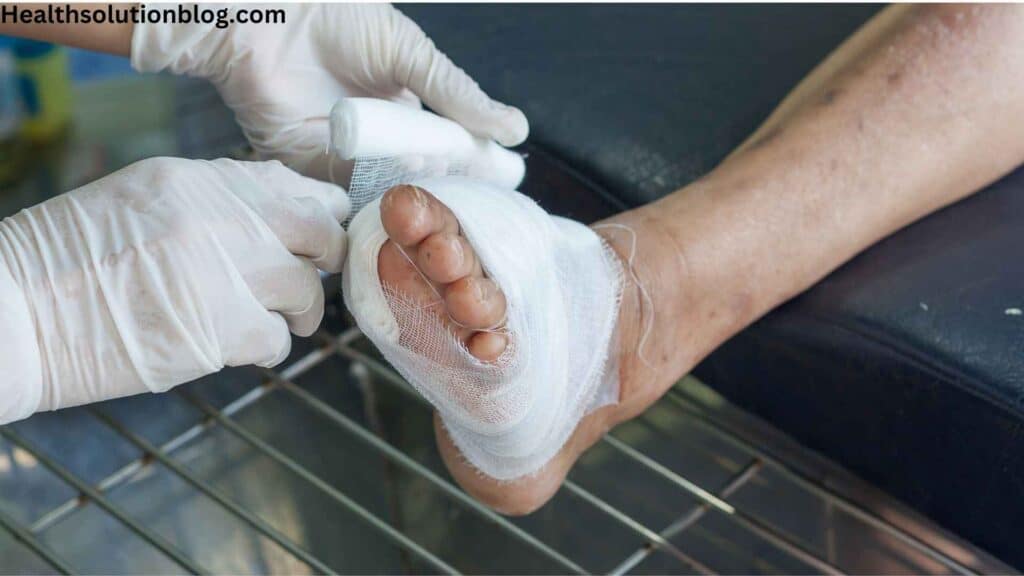
People with diabetes are more likely to develop foot problems than people without diabetes. This is because diabetes can damage the nerves and blood vessels in the feet, which can make it difficult to feel pain or detect injuries.
Some of the most common foot problems among people with diabetes include:
i. Cuts, sores, or red spots:
These can be caused by minor injuries, such as stubbing your toe or stepping on a sharp object. If a cut or sore is not treated properly, it can become infected.
ii. Swelling or fluid-filled blisters:
These can be caused by friction or pressure from shoes that are too tight.
iii. Ingrown toenails:
This occurs when the edge of the toenail grows into the skin. It can be painful and can lead to infection.
iv. Corns or calluses:
These are areas of thickened skin that are caused by friction or pressure. They can be painful and make it difficult to walk.
v. Plantar warts:
These are small, hard growths on the bottom of the foot. They are caused by a virus and can be painful.
vi. Athlete’s foot:
This is a fungal infection that causes itching, redness, and scaling of the skin between the toes.
vii. Warm spots:
These can be signs of infection. If you notice any of these problems, it is important to see your doctor right away to prevent further complications.
III. The Right Fit for Diabetic Foot Health
Properly fitting shoes are essential for people with diabetes, as they can help to prevent foot problems such as ulcers, infections, and amputations. Here are some tips for finding the right shoes for your diabetic feet.
Why Proper Fit Is Crucial?

People with diabetes are at an increased risk of developing foot problems, such as ulcers, infections, and amputations. This is because diabetes can damage the nerves and blood vessels in the feet, which can impair sensation and circulation. Properly fitting shoes can help to prevent these problems by:
- Providing adequate support: Shoes that fit properly will provide the necessary support for the arches and ankles, which can help to reduce pain and prevent injuries.
- Preventing rubbing and blisters: Shoes that fit properly will not rub or blister the feet, which can help to prevent infections.
- Distributing pressure evenly: Shoes that fit properly will distribute pressure evenly across the foot, which can help to prevent ulcers.
Custom Orthotics for Diabetic Feet

The term “custom orthotics” refers to inserts that are created specifically for each person’s foot. They can help to address alignment issues, as well as provide extra support and cushioning. People with diabetes may benefit from using custom orthotics since they can assist in preventing foot issues and enhance overall foot health.
Ensuring Stability as You Age
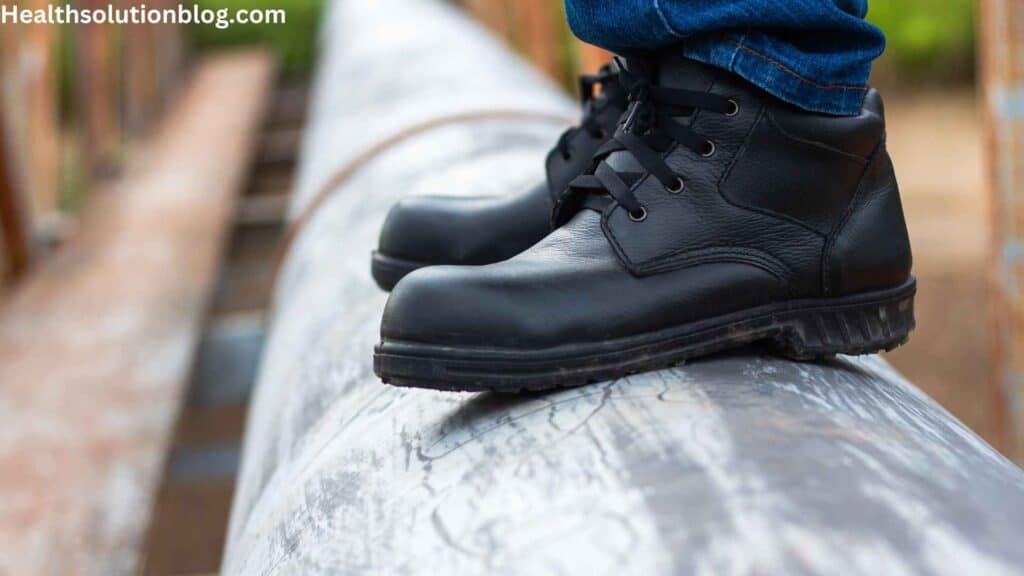
People are more likely to have changes in their feet as they age, such as loss of strength and flexibility. The search for shoes that are comfortable and offer the required support may become more challenging as a result of these changes. People with diabetes should take extra caution when selecting shoes as they get older since they run a higher risk of developing foot issues.
iV. Choosing the Right Diabetic Shoes
When choosing diabetic shoes, it is important to consider the fit, width, materials, support, cushioning, and closure. It is also important to factor in the price, style, brand, comfort, and warranty.
Shoe Selection Tips for Diabetic Footcare
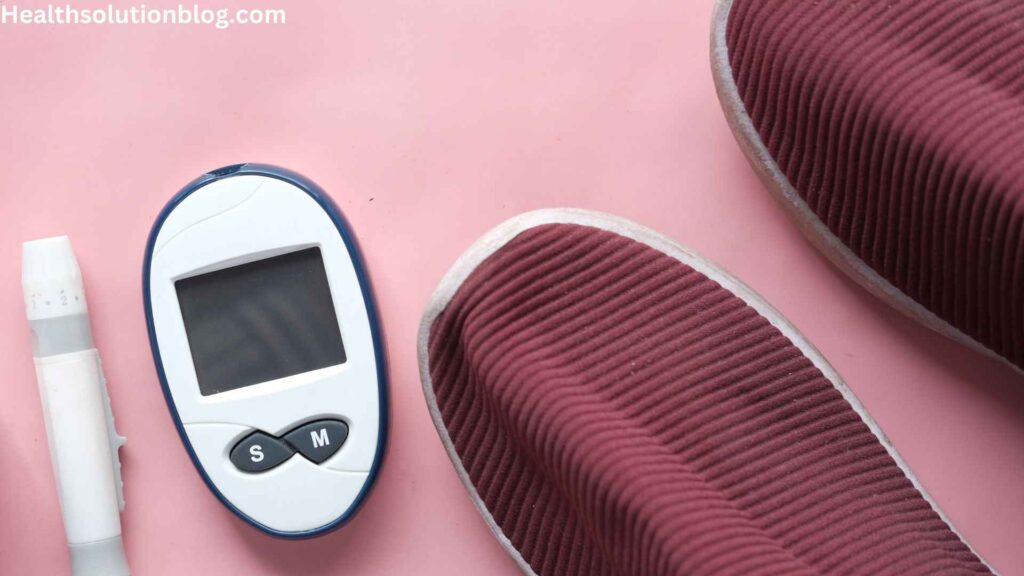
When choosing diabetic shoes, it is important to consider the following factors:
i. The fit: The shoes should fit snugly but not too tightly. There should be enough room for your toes to wiggle, but the shoes should not be loose enough to slip off.
ii. The width: The shoes should have a wide toe box to accommodate missing toes.
iii. The materials: The shoes should be made from soft, breathable materials to prevent moisture buildup.
iv. The support: The shoes should provide adequate support for the arches and ankles.
v. The cushioning: The shoes should have a cushioned footbed to provide comfort and support.
vi. The closure: The shoes should have a closure that is easy to use, such as laces or zippers.
Factors to Consider When Shopping for Diabetic Shoes
When shopping for diabetic shoes, there are a few factors to consider:
i. Price: Diabetic shoes can range in price from a few hundred dollars to over a thousand dollars. It is important to set a budget before you start shopping.
ii. Style: Diabetic shoes come in a variety of styles, from casual to dressy. Choose a style that you like and that will be comfortable to wear.
iii. Brand: There are a number of brands that sell diabetic shoes. Some popular brands include Orthofeet, Apex Flex, Drew Shoes, and Vionic.
iv. Comfort: The most important factor to consider when shopping for diabetic shoes is comfort. The shoes should be comfortable to wear and provide the necessary support.
v. Warranty: Some diabetic shoes come with a warranty. This can be a valuable benefit, as it can provide you with peace of mind regarding the quality and durability of your purchase.
Top 10 Best Diabetic Shoes for Amputated Toes
Here are the top 10 best diabetic shoes for amputated toes, each with a category:
1. Orthofeet Innovative Diabetic Shoes for Men
The Orthofeet Innovative Diabetic Shoes for Men are designed to provide comfort and protection for people with diabetes. They have a number of features that make them ideal for people with foot problems, including arch support, heel cushioning, and a wide toe box.
Features
Arch support:
Provides support for the arches of the feet to relieve pain and discomfort.
Heel cushioning:
Absorbs shock and protects the feet from impact.
Wide toe box:
Allows the toes to spread out naturally to prevent problems such as bunions and hammertoes.
Rubber sole:
Provides traction and stability to prevent slips and falls.
Extended widths:
Available in a variety of widths to accommodate a variety of foot types.
Amputated toe design:
Accommodates missing toes to prevent rubbing and blisters.
Pros
- Provides arch support and heel cushioning
- Has a wide-toe box
- Is made with a rubber sole for traction and stability
- Is available in extended widths
- Is comfortable to wear
- Is backed by a satisfaction guarantee
- Accommodates missing toes
Cons
- Can be a bit pricey
- May not be suitable for everyone with foot problems.
2. Dr. Comfort Carter Men’s Diabetic Shoes-Stretchable & Washable
The Dr. Comfort Carter Men’s Diabetic Shoes are machine-washable, casual shoes that feature double-depth construction. They are made with Lycra uppers and a rubber sole. The shoes have a customizable fit with an adjustable contact closure. They are also seamless to help prevent skin irritation.
Product Details:
Dr. Comfort Carter Mens Casual Shoe
Material: 100% Leather
Sole: Rubber sole
Style: Men’s Double Depth Casual Shoe
Additional Features: Protective toe box, contact closure for comfort and support.
Key Features:
1. Double-depth construction:
Engineered with double-depth construction, these shoes provide extra space to accommodate severe edema, internal braces, and AFOs (Ankle-Foot Orthoses). This ensures a comfortable fit even for those with unique foot conditions.
2. Customizable Fit:
The adjustable contact closure system allows for easy customization, ensuring a personalized fit that maximizes comfort. Say goodbye to discomfort and hello to a shoe tailored to your needs.
3. Breathable Lycra Uppers:
Crafted with durable and breathable Lycra material, these shoes not only keep your feet comfortable but also allow for machine washing, ensuring easy maintenance.
4. Seamless Design:
The seamless design of these shoes goes the extra mile to prevent skin irritation, offering unmatched comfort throughout the day.
5. Dr. Comfort Technology:
Dr. Comfort employs cutting-edge technology, top-quality materials, and expert craftsmanship to create shoes that cater to individuals with diabetes. These shoes are designed to protect your feet from the complications associated with diabetes.
Fitting Tips:
The Lycra upper of this shoe is stretchable, making it an excellent choice for individuals with hammertoes and bunions. If you find the shoe feels roomy, ordering one width narrower can provide a more snug and comfortable fit.
Pros
- Provides extra depth to accommodate for swelling or deformities
- Customizable fit for a comfortable and supportive feel
- Breathable and durable materials
- Slip-resistant sole for added safety
- Machine-washable for easy cleaning
- Comes with gel insoles for additional comfort
Cons
- May be too loose for people with narrow feet.
3. YH SUCED Women’s Diabetic Shoes Width X-Wide Magic Buckle Shoe for Elderly Women
The YH SUCED Women’s Diabetic Shoes are a pair of diabetic shoes designed for elderly women with swollen feet, edema, plantar fasciitis, or amputated toes. They feature a wide width, an adjustable closure, and a comfortable memory foam insole.
Key Features:
1. Exceptionally Comfortable Memory Foam Insole:
Each pair of these diabetic shoes includes two insoles, with one featuring a memory sponge for an incredibly comfortable foot feel. These insoles are replaceable, allowing you to customize the shoes to suit your specific needs, even if you have diabetes and amputated toes.
2. Anti-Skid and Shock Absorption Sole:
The X-wide rubber sole is not only wear-resistant but also anti-slip, providing secure footing and preventing slips. The air cushion design in the heel absorbs shock, making every step comfortable, which is essential for individuals with diabetic amputated toes.
3. Easy to Put On and Off:
The adjustable magic buckle fastener simplifies putting on and taking off these walking shoes, offering added convenience for elderly individuals and those dealing with conditions like swollen feet, edema, and plantar fasciitis, including those with diabetic amputated toes.
4. Lightweight and Breathable Upper:
The lightweight and breathable upper ensures your feet stay fresh and comfortable throughout the day. The flying woven upper material and breathable lining enhance the overall breathability of the shoes, catering to the comfort of individuals with diabetic amputated toes.
5. YH SUCED Brand Diabetic Shoes:
YH SUCED is dedicated to addressing the unique health concerns of diabetic patients and the elderly, including those with diabetic amputated toes. These diabetic shoes exemplify their commitment to comfort and quality.
6. Widening and Enlarging Design:
Ensures maximum comfort for wider feet and amputated toes.
7. Breathable Fly Woven Material:
Lightweight and breathable with a convenient magic buckle design.
8. MD + Rubber + Air Cushion Sole:
Light and non-slip for confident walking.
9. Memory Foam Insole:
Provides exceptional foot comfort.
10. Width X-Wide Casual Magic Buckle Shoes:
These diabetic shoes offer relief from foot discomfort with their adjustable, magic buckle design, making them easy to put on and take off, an essential feature for individuals with diabetic amputated toes.
11. Two-Piece Insole for Personalized Comfort:
YH SUCED provides two insoles with each pair of shoes, allowing you to adjust the shoe size for a more customized and comfortable fit. The memory foam insole ensures extreme foot comfort for those with amputated diabetic toes.
12. Anti-Skid and Shock Absorption Sole:
These diabetic shoes feature an X-wide rubber bottom that is highly wear-resistant and anti-slip, providing secure walking and shock absorption, making them suitable for individuals with diabetic amputated toes.
13. Lightweight and Breathable:
The shoes’ lightweight and breathable upper and lining keep your feet dry and comfortable, ensuring a pleasant walking experience for those with diabetic amputated toes.
Pros
- Comfortable and supportive
- Easy to put on and take off
- A wide width accommodates swollen feet
- Breathable uppers keep feet cool and dry
- A non-slip sole prevents falls
- Two-piece insoles allow for customization
Cons
- May not be stylish for some people
- Not machine-washable
4. Silvert’s Adaptive Clothing & Footwear Men’s Double-Extra Wide Slip-Resistant Slippers for Seniors
The Silvert’s Adaptive Clothing & Footwear Men’s Double-Extra Wide Slip-Resistant Slippers for Seniors are a great option for men with diabetic amputated toes. They are extra wide and have a deep, roomy design to accommodate swollen feet and ankles. They also have a removable insole and foam spacer, which can be used to accommodate orthotics. Additionally, the shoes have a slip-resistant sole to help prevent slips and falls.
Key Features:
1. Easy Self Dressing:
Thanks to adjustable closures with hook-and-loop fasteners and a design that allows the shoe to open all the way for easy access, these house sneaker slippers for men are incredibly easy to put on and take off. The wide fit is exceptionally accommodating for elderly men and those with amputated diabetic toes.
2. Fluid Barrier:
Equipped with the Fluid Barrier Advantage, these anti-slip shoes protect against spills and odors. They are recommended for aging individuals dealing with incontinence or any situation where fluids are present, making them a suitable choice for diabetic amputated toes.
3. Premium Comfort:
Engineered with a deep, roomy design, these sneaker slippers offer extreme comfort for swollen feet and ankles. They are often referred to as diabetic slippers for men due to their comfort and suitability for diabetic amputated toes and other foot conditions.
4. Removable Insole & Spacer:
These shoes include a removable insole and foam spacer, providing the flexibility to accommodate custom orthotics or those with specific comfort preferences, including individuals with diabetic amputated toes.
5. Tested Slip Resistance:
Handicapped shoes require slip-resistant soles to prevent slips and falls. These senior sneakers offer the perfect amount of grip for virtually any surface, ensuring safety for individuals, including those with diabetic amputated toes.
Versatile Uses:
Due to their wide fit, supreme comfort, and versatility, these big house slippers sneakers are often used as swollen feet shoes, diabetic shoes for men with wide width, edema shoes for swollen feet, wide tennis shoes for disabled individuals, and elderly walking shoes. They are recommended in homes, hospitals, rehabilitation facilities, assisted living facilities, nursing homes, and are especially beneficial for individuals with diabetic amputated toes.
Size & Color Options:
These slipper shoes for men indoors and outdoors are available in sizes 7–14 and come in Black, Steel, Navy, and Camo options.
Giving Back to Charity:
Silvert’s is a proud supporter of the Alzheimer Society of Canada, with a portion of proceeds dedicated to funding research to find a cure and improve the quality of life for people living with dementia.
Pros
- Comfortable and supportive
- Extra-wide toe box accommodate amputated toes
- Adjustable closures for a customized fit
- Removable insole and foam spacer for orthotics
- Tested slip-resistant soles
- Fluid barriers protect against spills and smells
- Versatile and can be used for a variety of activities
Cons
- May not be as stylish as some other slippers
5. FitVille Diabetic Shoes for Men Extra Wide Width Orthopedic Slip-on Shoes
The FitVille Diabetic Shoes for Men Extra Wide Width Orthopedic Slip-on Shoes are a comfortable and supportive option for people with diabetic amputated toes. They have a number of features that make them well-suited for this condition, including an extra wide toe box, adjustable closure, cushioned footbed, and breathable upper.
Features
Extra wide toe box:
This provides plenty of room for feet with amputated toes, helping to prevent rubbing and blisters.
Adjustable closure:
This allows you to get a snug and comfortable fit, even if your feet are swollen or have different widths.
Cushioned footbed:
This provides added cushioning and support for the feet, which can help to relieve pain and discomfort.
Breathable upper:
This helps to keep the feet cool and dry, which can help to prevent infection.
Patented Therapeutic Sole:
Relief of foot pain due to neuropathy, and the solid heel ring makes your steps steady
Ergonomic Design:
Fitted foot support design to reduce the burden on your feet.
Stretchy Padded Upper:
Provide proper care and protection for your feet.
Breathable Inner Material:
Maintain internal air circulation to keep your feet dry and cool.
Pros
- Comfortable and supportive
- Extra wide toe box accommodates amputated toes
- Adjustable closure for a customized fit
- Cushioned footbed for added comfort
- Breathable upper to keep feet cool and dry
- Patented therapeutic sole for pain relief
- Ergonomic design for reduced foot fatigue
- Stretchy padded upper for comfort and protection
- Breathable inner material for cool, dry feet
Cons
- May be more expensive than some other diabetic shoes
- Not machine-washable.
6. Womens Stylish Diabetic Shoes Extra Wide Widths Walking Edema Sneakers
Women’s Stylish Diabetic Shoes, specially designed to cater to unique foot needs, including those with diabetic amputated toes. These walking edema sneakers offer a host of features that make them an ideal choice for individuals seeking a comfortable and supportive footwear solution.
Features
Extra wide toe box:
This provides plenty of room for feet with amputated toes, helping to prevent rubbing and blisters.
Adjustable straps:
The adjustable straps allow you to get a snug and comfortable fit, even if your feet are swollen or have different widths.
Removable insoles:
The removable insoles allow you to customize the fit of the shoes and add orthotics or custom inserts if needed.
Breathable upper:
The breathable upper helps to keep the feet cool and dry, which can help to prevent infection.
Supportive sole:
The supportive sole helps to provide arch support and reduce pain.
3 pairs of insoles:
The shoes come with 3 pairs of insoles, so you can choose the ones that provide the best fit and support for your feet.
Easy to put on and take off:
The adjustable straps make it easy to put on and take off the shoes, even if you have limited mobility.
Comfortable and supportive:
The shoes are made with a variety of materials that provide comfort and support, including memory foam insoles and a breathable upper.
Stylish and versatile:
The shoes are available in a variety of colors and styles, so you can find a pair that fits your taste and needs.
Durable and long-lasting:
The shoes are made with high-quality materials that are designed to last.
Pros
- Comfortable and supportive
- Extra wide toe box accommodates amputated toes
- Adjustable straps for a customized fit
- Removable insoles for orthotics
- Breathable upper keeps feet cool and dry
- Supportive sole reduces pain
- 3 pairs of insoles included
- Stylish and versatile
- Durable and long-lasting
Cons
- May not be as affordable as some other diabetic shoes
7. BraceAbility Forefoot Off-Loading Healing Shoe
The BraceAbility Forefoot Off-Loading Healing Shoe is a medical boot designed to protect the forefoot and toes during healing from a variety of foot conditions. It has a 15-degree dorsi-angle bottom, which forces the wearer to shift their weight to their heel when walking. This helps to reduce pressure on the forefoot and toes, which can promote healing.
Features
15-degree dorsi-angle bottom:
This forces the wearer to shift their weight to their heel when walking, which can help to reduce pressure on the forefoot and toes.
Square-toe design:
This provides plenty of room for comfort and acts as a protective bumper against further damage.
Adjustable medical-grade fastener straps:
These straps easily accommodate bandaging and swelling.
Soft, durable material:
This material is breathable for all-day comfort.
Orthopedic foam insole:
This insole provides heel support, cushioning, and shock absorption.
Pros
- Protects the forefoot and toes
- Forces the wearer to shift their weight to their heel, which can promote healing
- Square-toe design provides plenty of room for comfort and acts as a protective bumper
- Adjustable medical-grade fastener straps easily accommodate bandaging and swelling
- Made from soft, durable material that is breathable for all-day comfort
- Orthopedic foam insole provides heel support, cushioning, and shock absorption
Cons
- May not be comfortable for people with wide feet
- May not be suitable for all foot conditions
- May be difficult to walk in at first
Overall, the BraceAbility Forefoot Off-Loading Healing Shoe is a good option for people who are recovering from a foot injury or surgery that requires them to keep weight off their forefoot and toes. It is important to talk to your doctor before using this shoe to make sure it is right for you.
8. Orthopedic Walking Shoes Diabetic Bunions – Coral Women’s Sneakers
The Orthofeet Ideal for Plantar Fasciitis, Foot and Heel Pain Relief. Extended Widths. Orthopedic Walking Shoes Diabetic Bunions are a comfortable and supportive option for women with a variety of foot conditions, including plantar fasciitis, foot and heel pain, diabetes, arthritis, bunions, Achilles tendonitis, hammer toes, and more.
Features
Comfortable and supportive:
The shoes are made with a variety of materials that provide comfort and support, including a soft, padded fabric interior and an anatomic arch support.
Bunion-friendly:
The shoes have a wide toe box that provides plenty of room for bunions to spread out.
Extended widths:
The shoes are available in a variety of widths, so you can find a pair that fits your feet perfectly.
Machine-washable:
The shoes are machine-washable, which makes them easy to keep clean.
Slip-resistant sole:
The sole of the shoe is slip-resistant, which helps to prevent falls.
Pros
- Comfortable and supportive
- Bunion-friendly
- Extended widths
- Machine-washable
- Slip-resistant sole
Cons
- May not be as stylish as some other shoes.
9. Orthofeet Women’s Orthopedic Tie-Less Sneakers
The Orthofeet Women’s Orthopedic Tie-Less Sneakers – Relieve Foot Pain Tahoe are a comfortable and supportive option for women with a variety of foot conditions, including plantar fasciitis, foot and heel pain, diabetes, arthritis, bunions, achilles tendonitis, hammer toes, and more.
Features
Comfortable and supportive:
The shoes are made with a variety of materials that provide comfort and support, including a soft, padded fabric interior and an anatomic arch support.
Bunion-friendly:
The shoes have a wide toe box that provides plenty of room for bunions to spread out.
Extended widths:
The shoes are available in a variety of widths, so you can find a pair that fits your feet perfectly.
Machine-washable:
The shoes are machine-washable, which makes them easy to keep clean.
Slip-resistant sole:
The sole of the shoe is slip-resistant, which helps to prevent falls.
Tie-less design:
This allows for easy on/off wear, eliminating the need to tie laces. This can be helpful for people with difficulty bending down or tying laces.
Anatomic arch support and heel cushioning:
These features provide comfort and support for the arches and heels, which can help to relieve pain and inflammation.
Premium orthotic insole and arch booster:
These insoles provide additional arch support and cushioning, which can further help to relieve pain and improve comfort.
Wide toe-box:
This provides plenty of room for the toes to spread out, which can help to prevent pain and discomfort.
Rubber sole:
The sole of the shoe is made of rubber, which provides good traction and prevents slipping.
Pros
- Comfortable and supportive
- Bunion-friendly
- Extended widths
- Machine-washable
- Slip-resistant sole
- Tie-less design
- Removable insole
Cons
- May not be as stylish as some other shoes.
10. Git-up Diabetic Slippers
The Git-up Diabetic Slippers for Women House Indoor Outdoor Shoes with Rubber Sole are a good option for women who are looking for comfortable and supportive slippers. They have a number of features that make them well-suited for people with diabetes, arthritis, edema, inflammation, prevent sweating, and prevent slipping.
Key Features:
1. High-Quality Knitting Plush:
Crafted with high-quality knitting plush that absorbs moisture quickly, these slippers ensure your feet stay dry and comfortable. The environment-friendly and waterproof TR rubber sole provides excellent anti-slip protection for your safety.
2. Adjustable Hook and Loop Closure:
Featuring flexible hook and loop straps, these slippers are easy to adjust to the width of your feet. Whether you have swollen feet or just need better stability, these slippers provide a customized fit that embraces your feet securely.
3. Soft and Comfortable Memory Foam:
The high-density memory foam construction creates a cushioning effect with every step. It feels like walking on pillows, making these slippers perfect for all-day wear, whether you’re walking or standing.
4. Versatile Usage and Target Users:
These slippers cater to a wide range of users, including pregnant women, doctors, soldiers, adults, and anyone in need of ultimate comfort. Whether you’re at home, in the office, at school, or in a hospital, these slippers offer much-needed relief for swollen feet, flatfoot, Talipes Valgus, splayfoot, and more.
Satisfaction Guarantee:
Your purchase comes with a satisfaction guarantee, so you’re taking no risk. If for any reason you’re not satisfied, simply let us know, and we’ll do our best to provide you with the most satisfactory solution. We offer a 100% no-risk money-back guarantee because your comfort and happiness are our priorities.
Size Chart (Women’s):
Note: If your feet are wider or you have a higher instep, we recommend selecting ONE SIZE UP for a more comfortable fit.
Size US 6 = Length: 9.65″ = 245MM
Size US 7 = Length: 10.04″ = 255MM
Size US 8 = Length: 10.27″ = 260MM
Size US 9 = Length: 10.63″ = 270MM
Size US 10 = Length: 10.87″ = 275MM
Size US 11 = Length: 11.22″ = 285MM
Pros:
- Comfortable and supportive
- Open-toe design for ventilation
- Adjustable hook-and-loop closure for a snug fit
- Rubber sole for traction
- Machine-washable
Cons:
- May not be as durable as some other slippers.
Conclusion:
In conclusion, it’s vital to take care of your feet if you have diabetes and amputated toes. Foot ulcers are common in people with diabetes, making the choice of the right diabetic shoes crucial. These special shoes, like those with off-loading devices and custom inserts, provide essential comfort and protection.
Understanding the need for a proper fit and the added benefits of custom insoles ensures that you stay comfortable and stable as you age. When picking diabetic shoes, consider factors like price, style, brand, and most importantly, comfort. Additionally, we have a list of the top 10 best diabetic shoes for amputated toes, handpicked to help you make the right choice.
Recognizing the unique needs of amputated toes, our article spotlights the top 10 best diabetic shoes for amputated toes—a carefully selected list to guide you toward the best diabetic shoes for your specific needs. Your comfort and well-being are worth investing in high-quality diabetic shoes. So, confidently step into a healthier future with the top 10 best diabetic shoes for amputated toes as your trusted companions.
Looking for neuropathy sandals. Check out this detailed article Top 14 Best Sandals For Neuropathy.
Frequently Asked Questions (FAQs) – Diabetic Shoes for Amputated Toes
Q1: Why is it crucial for diabetic individuals with amputated toes to wear specialized shoes?
A: Diabetic individuals with amputated toes require specialized shoes to ensure proper support, protection, and comfort. These shoes are designed to accommodate the unique needs and challenges that come with amputated toes, providing a secure and comfortable fit.
Q2: How do diabetic shoes differ from regular footwear?
A: Diabetic shoes are specifically designed to cater to the foot health needs of individuals with diabetes. They have features such as extra depth, cushioning, wide toe boxes, and soft materials to prevent pressure points and accommodate foot deformities like amputated toes. Regular footwear may lack these features.
Q3: What are the key considerations when choosing diabetic shoes for amputated toes?
A: When choosing diabetic shoes for amputated toes, consider factors such as proper fit, cushioning, arch support, stability, and the ability to accommodate custom orthotics or partial foot fillers. It’s essential to prioritize comfort, protection, and suitability for your specific condition.
Q4: How can diabetic shoes help prevent foot complications in individuals with amputated toes?
A: Diabetic shoes for amputated toes are designed to provide proper support, reduce pressure points, and prevent injuries. By ensuring a comfortable and well-fitting shoe, they can help prevent complications like ulcers, calluses, and skin irritations, promoting overall foot health.
Q5: Are there specific brands known for offering quality diabetic shoes for amputated toes?
A: Yes, several reputable brands offer diabetic shoes tailored to the needs of individuals with amputated toes, including Orthofeet, Dr. Comfort, Git-up, and more. These brands prioritize comfort, support, and quality materials in their footwear.
Q6: How can I find the right fit when shopping for diabetic shoes with amputated toes?
A: To find the right fit, measure your feet accurately and refer to the size chart provided by the manufacturer. Additionally, ensure the shoes have a wide toe box, are deep enough to accommodate any partial foot fillers, and provide a snug yet comfortable fit.
Q7: Can diabetic shoes for amputated toes assist in managing conditions like plantar fasciitis and arthritis?
A: Yes, diabetic shoes designed for individuals with amputated toes often offer features like arch support, cushioning, and proper alignment. These features can aid in managing conditions like plantar fasciitis, arthritis, and other foot-related ailments.
Q8: Where can I find a comprehensive list of the top-rated diabetic shoes for amputated toes?
A: For a comprehensive list of the top-rated diabetic shoes suitable for amputated toes, you can refer to the article on diabetic footwear. It provides insights into various brands, styles, and factors to consider when choosing the right diabetic shoes for individuals with amputated toes.
Q9: Are there specific care tips to prolong the life of diabetic shoes for amputated toes?
A: Proper care of diabetic shoes is essential for their longevity. Regularly clean and air-dry your shoes, avoid exposing them to extreme temperatures, and follow the manufacturer’s care instructions. It’s also advisable to rotate between pairs to reduce wear and tear.
Q10: How do I know if a diabetic shoe fits well for my amputated toes?
A: A well-fitting diabetic shoe for amputated toes should provide ample room for your toes, have a cushioned sole for comfort, and secure closure to keep your feet stable. Refer to the article for detailed tips on selecting diabetic shoes that fit perfectly for individuals with amputated toes.
Source:
https://diabetes.org/diabetes/foot-complications
https://www.niddk.nih.gov/health-information/diabetes/overview/preventing-problems/foot-problems















